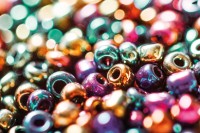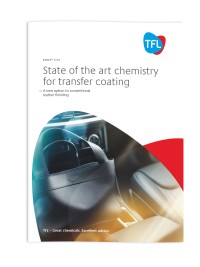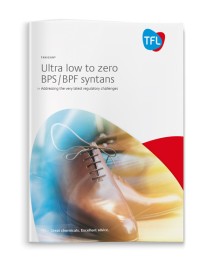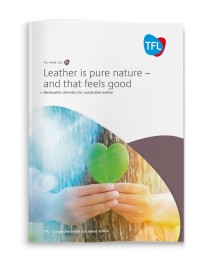Pressure to reduce chemical oxygen demand (COD) values at wastewater treatment plants is unlikely to become any less intense in the near future and this puts a sharp focus on the wet end of the tanning process as it is here that tanners can make changes that will yield the biggest benefits at the effluent treatment plant.
The head of wet end screening at leather chemicals manufacturer TFL, Florian Döppert, argues that if chrome-free leathers are a company's focus the impact on COD values in the wet-end wastewater can be high. He explains that this is because of the volumes of synthetic and natural tanning agents that manufacturers use to make chrome-free articles and the absence of a well distributed cationic charge to improve the fixation of anionic products in the hide.
New options
Work that Mr Döppert and his colleagues have done shows that the introduction of non-toxic cationic tanning agents in the wet-end process for chrome-free leathers creates "new options" for reducing the total amount of synthetic and natural tanning agents. Trials have shown that leathers with better hydrothermal fastness properties (clima test) and reduced plumping of the substance can be produced, while at the same time maintaining or even improving the physical properties.
In several of the applications, the main objective of reducing significantly the impact on wastewater was also achieved, with "a noticeable reduction" in COD values, while keeping the BOD values in a favourable ratio so that the wastewater became more biodegradable, according to the TFL team.
Not-so-secret ingredient
Zilconium is the not-so-secret ingredient in these non-toxic cationic tanning agents. Florian Döppert says: "This is an old story because zirconium has been around a long time. I found many interesting papers on the subject, but they were all too theoretical." He recounts his experience of developing "from scratch" processes for tanning and retanning using zirconium. Through trial and error, he found that a masked liquid agent with 22% ZrO2 worked well in retanning and in tanning from pickle. He makes the point that zirconium fares well in comparison with other metals from a toxicity and environmental point of view. It is the twentieth most abundant element on earth, has raised no concerns about skin irritation and presents very low concern for the aquatic environment, for example.
The quality of the leather the trials have produced was, ultimately, good, while at the effluent treatment plant, he achieved a reduction in COD and of total dissolved solids of almost 50%. So after all the trial and error a solution finally emerged.
Cautious optimism
What worked best in the end was a special masked liquid zirconium tanning agent with 22% ZrO2. The most successful recipe consisted of the following: 4% special masked zirconium tanning agent in liquid form; 12% liquid phenolic-naphthalene based syntan; 2% special filling polymer; 9% lecithin based fatliquor; 2% naphthalene based dispersing agent liquid, and 3% beige dye.
Compared to a standard chrome-free recipe, the TFL team found that the COD went down and the BOD went up, which is, of course, positive, because what works best in effluent treatment plants is when the ratio between COD and BOD is narrow.
For example, mixed-float samples showed COD of 6 grammes of oxygen per litre for the zirconium retanning recipe compared to 13 for the standard chrome-free recipe, and BOD of 2.1 compared to 1.5. Therefore the zirconium option Florian Döppert devised has a COD:BOD ratio of 2.8 compared to the standard recipe's 8.6.
He concludes: "There is a long way to go before we could talk about full tanning with zirconium, and it would be expensive to use it from the start of the tanning process in the quantities you would need; sufficient tanning of the hides occurs with offers of between 3% and 10% of ZrO2. But it certainly does make a lot of sense to use it in smaller quantities in retanning, especially on glutaraldehyde pre-tanned wet white."
Magazine: World Leather August/September 2018





 Main Reaction - The TFL Blog Stories, incidents, tips and facts around the topics leather, chemistry, fashion, sustainability and ecology. Our editorial staff consisting of experienced tanners, scientists, market experts, fashion and communication specialists has sharped their pencils and will supply you with fresh and inspiring content on a regular basis.
Main Reaction - The TFL Blog Stories, incidents, tips and facts around the topics leather, chemistry, fashion, sustainability and ecology. Our editorial staff consisting of experienced tanners, scientists, market experts, fashion and communication specialists has sharped their pencils and will supply you with fresh and inspiring content on a regular basis.


 LEVOTAN® / LUBRITAN™ - Looking for higher performance? Tanners around the world are facing increasing challenges from their customers, for example, demands for higher performance such as fastness to light and heat resistance, but also lighter weight leather and more recently odour / emissions avoidance.
LEVOTAN® / LUBRITAN™ - Looking for higher performance? Tanners around the world are facing increasing challenges from their customers, for example, demands for higher performance such as fastness to light and heat resistance, but also lighter weight leather and more recently odour / emissions avoidance.









